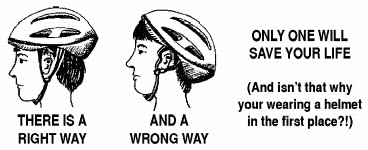You're getting ready to go out for your daily/weekly bike ride and you
put your helmet on as you do before any ride. You know the reasons
why helmet use is important:
- Of all cyclists killed (about 800 per year), approximately 75% die
of traumatic brain injuries. Up to 85% of these fatalities could have
been avoided through the use of a helmet.
- Most bicycle crashes involve falls and impacts with the roadway,
not motor vehicles, so wearing a helmet is important for every ride,
even when just riding on a path or near home.
- A bright helmet can increase your visibility to motorists.
- Bicyclists wearing helmets are often given more respect from
motorists than those without.
But is your helmet really protecting you? Only if you're wearing
it correctly. From informal observations done at large invitational
rides, races, and along paths and trails, as many as 60% of all riders
wear their helmets incorrectly. These individuals may say, "Well, at
least I'm wearing one,"or "Hey, it's better than nothing," but that's
not necessarily the case.
A bicycle helmet, like any piece of protective equipment, is designed
to be worn a certain way. When it's not, the manufacturer can't
guarantee that it will do what it's supposed to do: protect you.
So what is the correct way to wear a helmet? Level on the head (not
tilted up, back, or sideways), with the side and chin straps properly
adjusted and fastened securely. Follow the instructions below to make
sure you are wearing the right size helmet and that you are wearing it
correctly. *If you already own a helmet and it won't adjust right
after following these steps, you probably need to try another size or
brand.
- Start out with the smallest size helmet that fits your head. With
the foam padding removed, try on different sizes and brands of helmets
until you find one that fits the shape and size of your head. It
should cover the majority of your forehead, with only an inch or so of
skin exposed above your eyebrows. Even without the straps fastened or
the pads in place, there should be little movement when you move your
head from side to side.
- Now put in the foam pads that come with the helmet, allowing you
to get a "custom fit." Try out thin or thick ones where you need
them for fit and comfort.
- There are really five straps that need to be adjusted for a proper
fit. The ear straps are first, with each section of the strap (front
and back), and each side (left and right) done separately. When
adjusted correctly, each ear strap should meet at a point at your ear
lobe, with no loose play in the straps. Make sure you base your
adjustment decisions on the helmet being worn correctly, level on your
head! Only after these straps are adjusted should you try adjusting
the chin strap (which unfortunately is all most people do when fitting
a helmet). The chin strap should be snug, with room for only one or
two fingers between the strap and your chin.
- Check your adjustments by rocking your head from side to side and
back and forth. Also take the palm of your hand and try to push the
helmet up on your forehead. There should be little movement in any
of these actions. For added confidence, try standing in front of a
mirror while making and checking these adjustments.
Following these steps will ensure that your helmet is protecting your
head as it was designed to do. As long as the helmet meets certain
standards (Snell, ANSI, and/or ASTM) and you wear it every time you
ride, you've taken great strides in safeguarding that brain of yours.

Remember: Bicycle helmets are for injury prevention, not
accident prevention. Following the basic principles of Effective
Cycling is still the best way to ensure a safe ride:
- Ride on the right side of the roadway, never on the left and
never on the sidewalk.
- When you reach a more important or larger road than the one you
are on, yield to crossing traffic.
- When you intend to change lanes or move laterally on the roadway,
yield to traffic in the new lane or line of travel.
- When approaching an intersection, position yourself with respect
to your destination direction.
- Between intersections, position yourself according to your speed
relative to other traffic-slower traffic nearer the curb; faster
traffic nearer the centerline.
Reprinted from the November-December 1994 issue of "Bicycle USA",
magazine of the League of American Bicyclists.
For more information about the League of American Bicyclists, visit
their web site, www.bikeleague.org,
or e-mail them at bikeleague@aol.com.
|